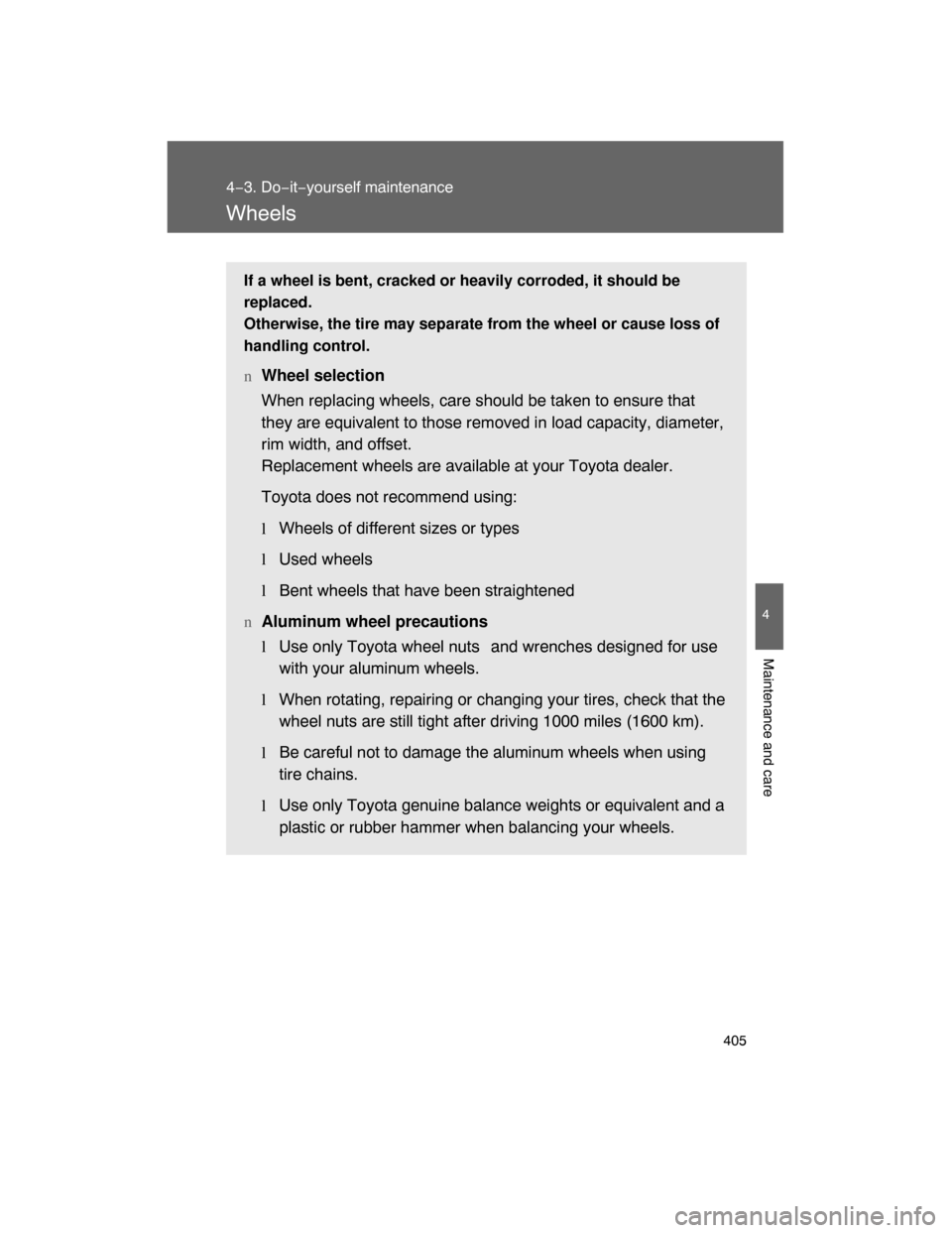Page 139 of 531

141
2−1. Driving procedures
2
When driving
nDriving in the rain
lDrive carefully when it is raining, because visibility will be reduced, the
windows may become fogged−up, and the road will be slippery.
lDrive carefully when it starts to rain, because the road surface will be
especially slippery.
lRefrain from high speeds when driving on an expressway in the rain,
because there may be a layer of water between the tires and the road
surface, preventing the steering and brakes from operating properly.
nBreaking in your new Toyota
To extend the life of the vehicle, the following precautions are recommended
to observe:
lFor the first 200 miles (300 km):
Avoid sudden stops.
lFor the first 500 miles (800 km):
Do not tow a trailer.
lFor the first 1000 miles (1600 km):
�Do not drive at extremely high speeds.
�Avoid sudden acceleration.
�Do not drive continuously in the low gears.
�Do not drive at a constant speed for extended periods.
nDrum�in�disc type parking brake system
Your vehicle has a drum−in−disc type parking brake system.
This type of brake system needs bedding−down of the brake shoes periodi−
cally or whenever the parking brake shoes and/or drums are replaced.
Have your Toyota dealer perform the bedding−down.
nOperating your vehicle in a foreign country
Comply with the relevant vehicle registration laws and confirm the availability
of the correct fuel. ( P. 496)
Page 222 of 531
224 2−5. Driving information
Selection tire chains
Use the correct tire chain size when mounting the snow chains.
Chain size is regulated for each tire size.
Side chain
(0.20 in. [5 mm] in diameter)
Cross chain
(0.25 in. [6.3 mm] in diameter)
Regulations on the use of tire chains
lRegulations regarding the use of tire chains vary according to loca−
tion and type of road. Always check local regulations before install−
ing chains.
l
Retighten the chains after driving 1/4 − 1/2 mile (0.5 − 1.0 km).
1
2
ITY25C045
nTire chains
Observe the following precautions when installing and removing chains.
lInstall and remove tire chains in a safe location.
lInstall tire chains on the rear tires.
lInstall tire chains following the instructions provided in the accompanying
manual.
Page 223 of 531

225
2−5. Driving information
2
When driving
CAUTION
nDriving with snow tires
Observe the following precautions to reduce the risk of accidents.
Failing to do so may result in a loss of vehicle control and cause death or
serious injury.
lUse tires of the size specified for your vehicle.
lMaintain the recommended level of tire inflation pressure.
lDo not drive in excess of 75 mph (120 km/h), regardless of the type of
snow tires being used.
lSnow tires should be installed on all wheels.
nDriving with tire chains
Observe the following precautions to reduce the risk of accidents.
Failing to do so may result in the vehicle being unable to be driven safely,
and may cause death or serious injury.
lDo not drive in excess of the speed limit specified for the tire chains being
used, or 30 mph (50 km/h), whichever is lower.
lAvoid driving on bumpy road surfaces or over potholes.
lAvoid sudden turns and braking, as use of chains may adversely affect
vehicle handling.
l
Slow down sufficiently before entering a curve to ensure that vehicle con−
trol is maintained.
Page 391 of 531

396 4−3. Do−it−yourself maintenance
nMaximum load of tire
Check that the maximum load of the re
placed tire is greater than 1/2 of
the Gross Axle Weight Ratings (GAWR) of either the front axle or the
rear axle, whichever is greater.
As for the maximum load of the tire, see the load limit at maximum cold
tire inflation pressure mentioned on the sidewall of the tire, and as for the
Gross Axle Weight Ratings (GAWR)
, see the Certification Label. ( P.
401, 507).
nTire types
1 Summer tires
Summer tires are high−speed performance tires best suited to highway
driving under dry conditions. Sinc
e summer tires do not have the same
traction performance as snow tire s, summer tires are inadequate for
driving on snow−covered or icy roads. For driving on snow−covered
roads or icy roads, the use of
snow tires is recommended. When
installing snow tires, be sure to replace all four tires.
2 All season tires
All season tires are designed to prov ide better traction in snow and to
be adequate for driving in most winter conditions, as well as for use
year round. All season tires, however, do not have adequate traction
performance compared with snow tires in heavy or loose snow. Also,
all season tires fall short in acceleration and handling performance
compared with summer tires in highway driving.
3Snow tires
For driving on snow−covered roads or icy roads, we recommend using
snow tires. If you need snow tires,
select tires of the same size, con−
struction and load capacity as the or iginally installed tires. Since your
vehicle has radial tires as original equipment, make sure your snow
tires also have radial construction. Do not install studded tires without
first checking local regulations for possible restriction. Snow tires
should be installed on all wheels. (
P. 222)
Page 400 of 531

405
4−3. Do−it−yourself maintenance
4
Maintenance and care
Wheels
If a wheel is bent, cracked or heavily corroded, it should be
replaced.
Otherwise, the tire may separate from the wheel or cause loss of
handling control.
nWheel selection
When replacing wheels, care should be taken to ensure that
they are equivalent to those removed in load capacity, diameter,
rim width, and offset.
Replacement wheels are available at your Toyota dealer.
Toyota does not recommend using:
lWheels of different sizes or types
lUsed wheels
l
Bent wheels that have been straightened
n
Aluminum wheel precautions
l
Use only Toyota wheel nuts and wrenches designed for use
with your aluminum wheels.
l
When rotating, repairing or changing your tires, check that the
wheel nuts are still tight after driving 1000 miles (1600 km).
lBe careful not to damage the aluminum wheels when using
tire chains.
lUse only Toyota genuine balance weights or equivalent and a
plastic or rubber hammer when balancing your wheels.
Page 450 of 531

456 5−2. Steps to take in an emergency
nIf the tire pressure warning system is inoperative
The tire pressure warning system
will become inoperati ve in the follow−
ing conditions:
(When the condition becomes normal, the system will work properly.)
lIf tires not equipped with tire pressure warning valves and transmit−
ters are used.
lIf the ID code on the tire pressure warning valves and transmitters is
not registered in the tire pressure warning computer.
lIf the tire inflation pressure is more than 73 psi (500 kPa, 5.1 kgf/cm2
or bar).
The tire pressure warning system may become inoperative in the follow−
ing conditions:
(When the condition becomes normal, the system will work properly.)
lIf electronic devices or facilities us ing similar radio wave frequencies
are nearby.
lIf a radio set at similar frequencies is in use in the vehicle.
lIf a window tint that affects the radio wave signals is installed.
lIf there is a lot of snow or ice on the vehicle, in particular around the
wheels or wheel housings.
lIf non−genuine Toyota wheels are used. (Even if you use Toyota
wheels, the tire pressu re warning system may not work properly with
some types of tires.)
lIf tire chains are used.
lIf the spare tire is in a location subject to poor radio wave signal
reception.
lIf a large metallic object which caninterfere with sign al reception is
put in the luggage compartment.
nIf the tire pressure warning light comes on after blinking for 1
minute frequently
If the tire pressure warning light comes on after blinking 1 minute fre−
quently when the “ENGINE START STOP” switch is turned to IGNITION
ON mode, have it checked by Toyota dealer.
Page 501 of 531
508 6−1. Specifications
Typical DOT and tire identification number (TIN)
DOT symbol
*
Tire Identification Number
(TIN)
Tire manufacturer ’s identifica−
tion mark
Tire size code
Manufacturer ’s optional tire
type code (3 or 4 letters)
Manufacturing week
Manufacturing year
*:The DOT symbol certifies that
the tire conforms to applicable
Federal Motor Vehicle Safety
Standards.
Maximum cold tire inflation pressure ( P. 512)
This means the pressure to which a tire may be inflated.
TUBELESS or TUBE TYPE
A tubeless tire does not have a tube and air is directly filled in the
tire. A tube type tire has a tube inside the tire and the tube main−
tains the air pressure.
Radial tires or bias−ply tires
A radial tire has RADIAL on the sidewall. A tire not marked RADIAL is a
bias−ply tire.
ITY61C014
DOT EUJX JIS0103
Page 506 of 531

513
6−1. Specifications
6
Vehicle specifications
Tire related term Meaning
Normal occupant
weight150 lb. (68 kg) times the number of occupants
specified in the second column of Table 1
* that
follows
Occupant distributionDistribution of occupants in a vehicle as speci−
fied in the third column of Table 1
* below
Production options
weightThe combined weight of installed regular pro−
duction options weighing over 5 lb. (2.3 kg) in
excess of the standard items which they
replace, not previously considered in curb
weight or accessory weight, including heavy
duty brakes, ride levelers, roof rack, heavy duty
battery, and special trim
RimA metal support for a tire or a tire and tube
assembly upon which the tire beads are seated
Rim diameter
(Wheel diameter)Nominal diameter of the bead seat
Rim size designation Rim diameter and width
Rim type designationThe industry manufacturer ’s designation for a
rim by style or code
Rim width Nominal distance between rim flanges
Vehicle capacity
weight (Total load
capacity)The rated cargo and luggage load plus 150 lb.
(68 kg) times the vehicle’s designated seating
capacity
Vehicle maximum load
on the tire
The load on an individual tire that is determined
by distributing to each axle its share of the
maximum loaded vehicle weight, and dividing
by two